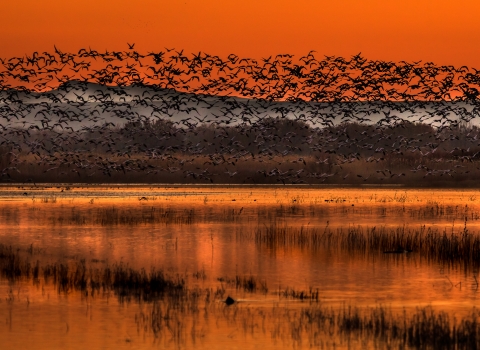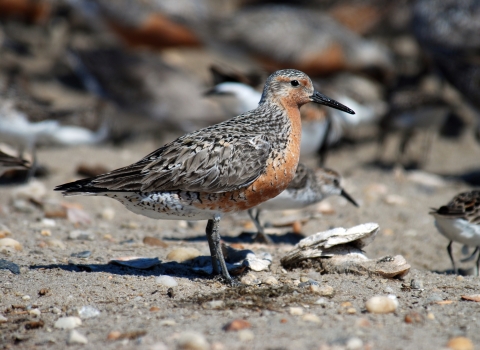Cherokee, North Carolina – The mountains of the Southern Appalachians were scraped clean a century ago as the canopy of trees that protected the streams from the noonday sun disappeared. Rainstorms pushed dirt and rocks into the water muddying the feeding and breeding grounds of fish, amphibians, and insects.
Lower down the mountain, newly cut pastures edged right up to the creeks while cows mucked up the once-pristine waters. Invasive bugs killed hemlocks, ash, and other shade-giving trees. Pipes, culverts, and dams blockaded streams and kept animals from cooler water.
The trout never had a chance.
And now they face an even more insidious foe – climate change climate change
Climate change includes both global warming driven by human-induced emissions of greenhouse gases and the resulting large-scale shifts in weather patterns. Though there have been previous periods of climatic change, since the mid-20th century humans have had an unprecedented impact on Earth's climate system and caused change on a global scale.
Learn more about climate change .
Higher temperatures, killer droughts, biblical rainstorms, and other climatic events pose an existential danger to the rainbow, brown, and brook trout that once filled the mountain streams of the Carolinas, Tennessee, Georgia, Virginia, and Alabama. Trout start blinking out once water temperatures rise above 70 degrees. The more conservative climate change scenarios predict a two- or three-degree average increase in Fahrenheit by 2100. Water temperatures, naturally, will rise too.
“We've had floods, and then droughts,” said Doug Reed, the supervisor the last 23 years at the trout hatchery run by the Eastern Band of Cherokee Indians. “We used to have good, healthier rivers just 10, 15 years ago. Now the rivers are a lot smaller. You can go upriver and see hundreds of tributaries that have dried up. We’re susceptible to whatever Mother Nature throws at us.”
Trout season is in full force across the Appalachians. Tribal, state, and federal hatcheries are delivering millions of fish to streams across the Southeast. Communities across the region await the economic benefits of trout fishing – roughly $400 million a year in North Carolina alone.
Anticipation runs high for another great year of fishing. But so too does anxiety, especially as the water warms, the fish stress, the hatcheries scramble, and the anglers wonder why catches are smaller, or, fewer.
“We’ve had good, solid summers where we’ve had a lot of rain, but the last couple of summers have not been good at all,” said Kelly Taylor who runs the Chattahoochee Forest National Fish Hatchery in the north Georgia mountains. “Sometimes we don’t have enough water coming through the creek. We’ve had to shut down some raceways and stock smaller fish. I’m not optimistic about this year.”
Stressed out trout
Taylor, that morning, hosted a fishing rodeo for kids with disabilities at the 45-acre hatchery shrouded by the mountains of the Chattahoochee National Forest. He checked the water temperature earlier.
“It was 58 degrees; this time of year, it should be down around 55 or 56,” Taylor said.
The hatchery, part of the U.S. Fish and Wildlife Service, was opened in 1937 when rail cars filled with milk cans delivered fish to tailwaters, streams, and lakes across north Georgia. Today, it grows a million rainbow, brown, and brook trout a year in 46 concrete raceways alongside the headwaters of the Toccoa River.
Chattahoochee is a stream-fed hatchery, dependent upon cool water from Rock and Mill creeks, unlike reservoir-fed hatcheries with their constant supply of below-60-degree water. And that’s where things get tricky.
Warmer water contains less oxygen than colder water. Fish get stressed out and sick as temperatures rise and oxygen decreases. Rainbow trout, the hardiest and fastest growing of the trout species, can survive in water temperatures up to 77 degrees. But they start stressing at 68 degrees and stop growing at 73 degrees. Georgia quits stocking trout once the temperature hits 73. Montana and other western states mandate “hoot owl” restrictions to keep anglers off the water from 2 p.m. until midnight when temperatures are hottest.
And it's only expected to get hotter. By 2100, surface air temperatures are likely to increase as much as five degrees Fahrenheit. Earlier, by 2060, western North Carolina may see up to 20 more days a year with temperatures over 95 degrees, according to the N.C. Institute for Climate Science.
Higher temps lead to lower flows, too, as evaporation sucks up water. Climate-induced droughts will also dry up streams and harm trout habitat. And, while the Southeast is likely to experience a moderate increase in rainfall over the ensuing decades, the precipitation is expected to come in fewer, yet more severe downpours which wash quickly through the system, scrub the waters of trout eggs, and silt up streams with dirt that can kill the macroinvertebrates trout eat.
Trout Unlimited, the cold-water fisheries nonprofit, says that 45 percent of the Southeast’s historical trout stream habitat has already disappeared. A near-three degree increase in temperatures will result in another 20 percent loss across the southern Appalachian range. A six-degree increase would wipe out nearly 80 percent of the trout’s homeland, according to the American Fisheries Society, a nonprofit conservation group.
“We're on the border of the Great Smoky Mountains National Park, a heavily protected watershed,” said Mike LaVoie, the natural resources director for the Cherokee. “But you can’t protect against floods, droughts, and disease. The concern with climate change is that we’ll have more events like those in the future.”
Where will trout go?
Wild brook trout -- the most prized, beautiful, and iconic of trout species – suffer the most. Their backs are speckled with yellow and red splotches encircled by blue halos, and their fins are pink and edged in white. Their inaccessibility, amid the highland rills above 3,000 feet and surrounded by thickets of rhododendron and towering oaks, adds to their cachet. They thrive in the healthiest of water: cold, pure, and hard to reach. So beloved are brookies that most anglers release the smallish (10-inches long if you’re lucky) trout soon after the obligatory iPhone photo.
That brook trout are the piscine equivalent of the coal-mine canary only furthers their mystique. As water temperatures rise, their domains disappear. Already near the mountaintops, where will the only native Appalachian trout go as the climate worsens?
“The water levels are getting lower in the higher, first-order streams,” said David “Gravy” Rowland, 47, a fish culturist at the Cherokee hatchery. “You’ve got to work to get to the small water where the wild trout are. You have to get up higher and higher, like, on top of Bunches Creek (elev. 4,500), to find ‘em.”
In 2018, North Carolina State University released a report entitled “Climate Change and Trout on the Qualla Boundary,” the 57,000-acre Cherokee reservation. The conclusions were ominous, particularly for brook trout.
“Model predictions suggest that even mild climate warming will result in a significant decrease in brook trout habitat, and that a substantial amount of habitat loss will occur in the next 10 to 25 years,” the report says.
Anywhere from 50-92 percent of brookie habitat could disappear over the next half century, depending on how much the climate warms. By 2100, only one stream on the reservation, Rough Branch, may still hold brook trout. It doesn’t help that an invasive bug is killing eastern hemlocks, the stream-hugging evergreen that blocks the sun and cools the water. A warming world facilitates the hemlock woolly adelgid’s northward march.
“Climate warming will have a severe impact on the native fishes and stream ecosystems of the Qualla Boundary,” the report concludes.
'A huge impact’
Including rainbow trout. And brown trout. And the hatcheries that grow them. Trout need more energy – food – as temperatures rise. As warmer water enters the raceways, the rainbows’ metabolic activity increases. Therefore, Taylor, Reed, and other hatchery managers must feed the largest, most common trout more food.
Liquid oxygen is another expense hatcheries increasingly shoulder due to climate change. The warmer the water, the less dissolved oxygen, and the more stress trout experience. Taylor, at the Chattahoochee hatchery, runs liquid oxygen lines to all 46 raceways.
“It causes us to put liquid oxygen on the fish earlier, so we’re using more and more of it,” he said while sitting alongside a rushing Rock Creek. “This time of year, we shouldn’t have to turn it on, but we started using it the first of May.”
Still, the trout succumb to disease. Columnaris, or saddleback disease, hits trout when air temperatures rise above 68 degrees. Warmer, less-oxygenated water weakens a fish’s immune system and makes them more susceptible to the waterborne bacteria. Crowded raceways don’t help. Pale patches, or saddle-shaped lesions, appear along the backs and dorsal fins of trout. The disease is highly contagious and often deadly. Hatchery managers add heavy doses of antibiotics to the fish food throughout the summer.
Drought, though, hits hatcheries, and anglers, hardest.
“In 2016, the drought had a huge impact on us,” said Reed, the Cherokee hatchery supervisor. “The water was so low that Raven Fork ran only through our intake. There was nothing left to run alongside the hatchery. We had to reduce capacity by 60 percent.”
Cherokee, typically, stocks 220,000 trout a year in boundary waters. In 2016, the Cherokee and Chattahoochee hatcheries released fish earlier, and smaller, than usual. Ideally, they stock 10-inch trout. Nine-inch trout, though, are released more frequently these days.
A lot of time and money has gone into reviving the Appalachian trout industry, ever since the early 1900s when non-native rainbows and browns were introduced to the Smokies (and forced native brook trout further upstream). The Service, along with other federal and state agencies, the Cherokee, and many nonprofits has, since 1990, removed non-native trout along 30 miles of stream habitat in the southern Appalachians. Low-head dams and culverts have been taken out or upgraded. Trees and shade-bearing bushes have been planted along streams.
A diversion dam on Raven Fork that steers water to a private trout hatchery is scheduled for demolition this year. The Service, the state of North Carolina, and nonprofits are raising $10 million to take down the Ela Dam along the Oconaluftee River. Each removal will open miles of cooler water for trout, smallmouth bass, and sicklefin redhorse.
“Conservation has helped over the last 40 years,” said Rowland, an enrolled member of the Cherokee Tribe, “but climate change fights against it.”
‘Brutal weeks’
No need to remind Michael Bradley. Bradley, too, is a tribal member, as well as a fly fishing guide and one of six members of Fly Fishing Team USA’s traveling team. He grew up between two creeks that feed the Oconaluftee.
“We were able to fish all summer. We thought it was the coldest river around,” Bradley, 32, said. “Now, we have some brutal weeks. I’ve watched temperatures go up. I’ve seen trout live in water that’s 70, 72 degrees, but they’re not active. If you catch one, it’s probably coming out of the river like it’s boiled.”
And that’s not good for business. Fifty-thousand anglers take to the reservation’s public waters each year. They pay nearly a million dollars a year for permits. And they kick in $26 million to the local economy – hotel reservations, restaurant tabs, Cherokee souvenirs, river-guide fees.
“I turn folks away in the summer because it’s too warm,” Bradley said before landing a foot-long rainbow in Raven Fork within three minutes. “I try and talk all my clients into coming from October to June.”
This story is part of a collaborative effort to explore how climate change is impacting hunting and fishing across the United States.







